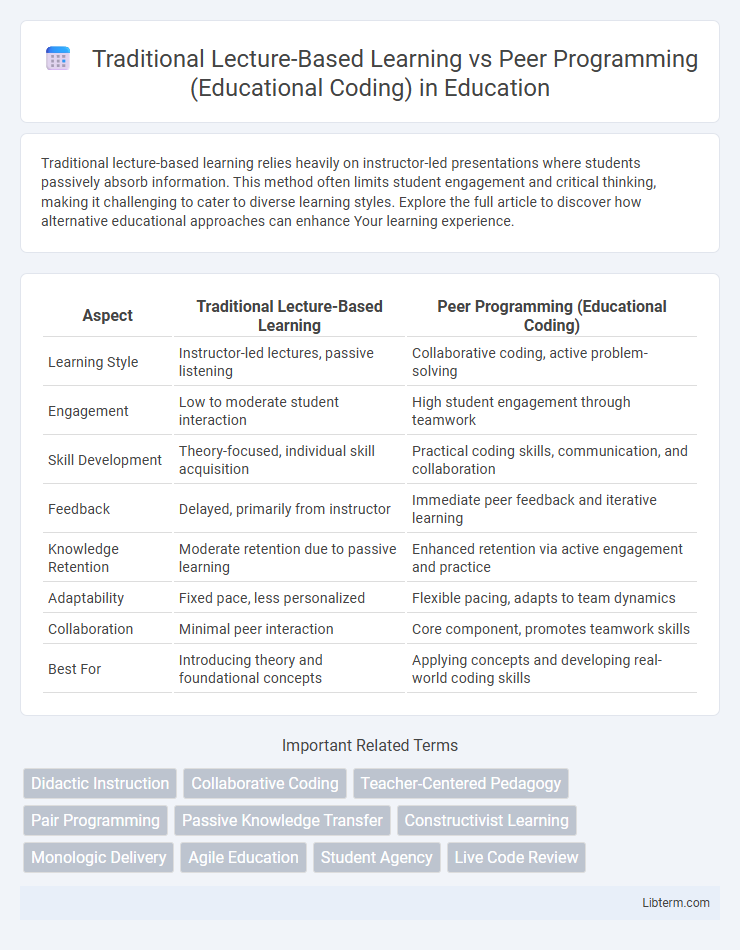Traditional lecture-based learning relies heavily on instructor-led presentations where students passively absorb information. This method often limits student engagement and critical thinking, making it challenging to cater to diverse learning styles. Explore the full article to discover how alternative educational approaches can enhance Your learning experience.
Table of Comparison
| Aspect | Traditional Lecture-Based Learning | Peer Programming (Educational Coding) |
|---|---|---|
| Learning Style | Instructor-led lectures, passive listening | Collaborative coding, active problem-solving |
| Engagement | Low to moderate student interaction | High student engagement through teamwork |
| Skill Development | Theory-focused, individual skill acquisition | Practical coding skills, communication, and collaboration |
| Feedback | Delayed, primarily from instructor | Immediate peer feedback and iterative learning |
| Knowledge Retention | Moderate retention due to passive learning | Enhanced retention via active engagement and practice |
| Adaptability | Fixed pace, less personalized | Flexible pacing, adapts to team dynamics |
| Collaboration | Minimal peer interaction | Core component, promotes teamwork skills |
| Best For | Introducing theory and foundational concepts | Applying concepts and developing real-world coding skills |
Introduction to Traditional Lecture-Based Learning
Traditional lecture-based learning in education typically involves an instructor delivering structured content to students in a classroom setting, emphasizing passive absorption of knowledge. This method prioritizes clear explanations, note-taking, and individual student performance on assessments to measure comprehension. While efficient for conveying foundational theories, it often limits interactive engagement and collaborative problem-solving opportunities critical in coding education.
Overview of Peer Programming in Education
Peer programming in education involves two students collaboratively coding, where one writes the code while the other reviews and provides real-time feedback, enhancing problem-solving skills and knowledge retention. This interactive approach contrasts with traditional lecture-based learning by promoting active engagement, immediate error correction, and improved communication skills among learners. Research indicates peer programming increases programming proficiency and student motivation, making it a valuable pedagogical strategy in computer science education.
Key Principles of Lecture-Based Teaching
Lecture-based teaching centers on structured, instructor-led delivery of content, emphasizing clear explanation of coding concepts, syntax, and algorithms to build foundational knowledge. It relies on passive learning where students absorb information through listening and note-taking, promoting individual understanding before practical application. This method prioritizes systematic progression through curriculum, ensuring consistency and comprehensive coverage of programming fundamentals.
Core Elements of Peer Programming
Peer programming enhances collaborative problem-solving by pairing students to share coding tasks, promoting active learning through continuous feedback and communication. Core elements include driver and navigator roles, encouraging real-time code review and joint decision-making that strengthen understanding and retention. This method improves coding skills and critical thinking, contrasting with traditional lecture-based learning's passive knowledge transfer.
Engagement and Participation Comparison
Peer programming significantly enhances student engagement and participation by fostering real-time collaboration, immediate problem-solving feedback, and active communication between partners. Traditional lecture-based learning often results in passive information absorption with limited opportunities for interaction, reducing student involvement in the coding process. Research indicates higher retention rates and deeper understanding in peer programming environments due to its interactive and participatory nature.
Knowledge Retention and Concept Mastery
Traditional lecture-based learning relies heavily on passive information absorption, often resulting in lower long-term knowledge retention and superficial concept mastery. Peer programming, as an active, collaborative educational coding method, enhances understanding by enabling immediate application, real-time problem-solving, and continuous feedback, fostering deeper concept mastery. Studies show that students engaged in peer programming demonstrate significantly higher retention rates and better ability to transfer coding concepts to new problems compared to those in lecture-based environments.
Collaboration and Communication Skills Development
Traditional lecture-based learning primarily emphasizes individual knowledge absorption, limiting opportunities for active collaboration and real-time communication among students. Peer programming fosters continuous interaction, enabling learners to develop critical communication skills through shared problem-solving and immediate feedback during coding tasks. This collaborative environment enhances teamwork abilities and practical dialogue, essential for success in modern software development.
Scalability and Classroom Management
Traditional lecture-based learning in coding offers scalability by allowing a single instructor to deliver content to large groups efficiently, but it often limits individual student engagement and real-time feedback. Peer programming enhances classroom management through collaborative learning dynamics, fostering active participation and immediate problem-solving, though it may require smaller groups or additional facilitation to maintain effectiveness as class size grows. Balancing these methods involves leveraging lecture scalability with structured peer programming sessions to optimize both knowledge transfer and classroom interaction.
Challenges and Limitations of Each Method
Traditional lecture-based learning often faces challenges such as passive student engagement, limited hands-on practice, and difficulty in accommodating diverse learning paces, reducing overall coding skill retention. Peer programming, while promoting collaboration and active problem-solving, can encounter limitations like unequal participation, potential conflicts between peers, and reliance on compatible skill levels to maintain productivity. Both methods require strategic integration of instructional support and learner feedback to overcome these barriers effectively.
Choosing the Right Approach for Coding Education
Traditional lecture-based learning emphasizes instructor-led explanations and structured knowledge delivery, which benefits students needing foundational understanding and theoretical context. Peer programming fosters collaborative problem-solving and real-time code review, enhancing critical thinking and practical skills through active engagement and communication. Choosing the right approach depends on balancing conceptual grasp with hands-on experience, adapting to learners' goals, coding proficiency, and preferred learning styles.
Traditional Lecture-Based Learning Infographic

 libterm.com
libterm.com